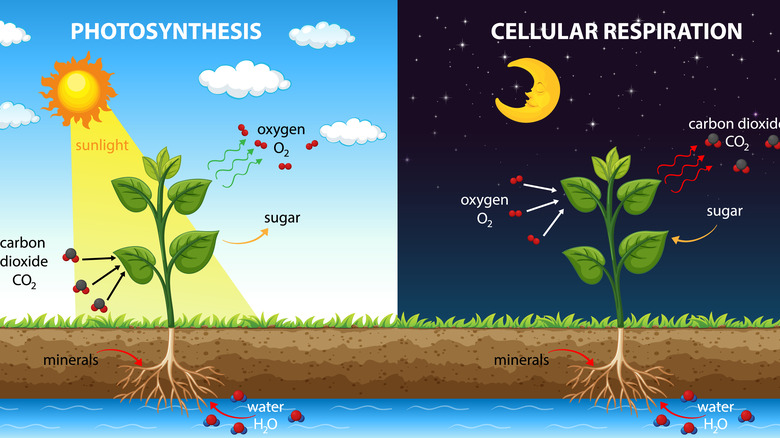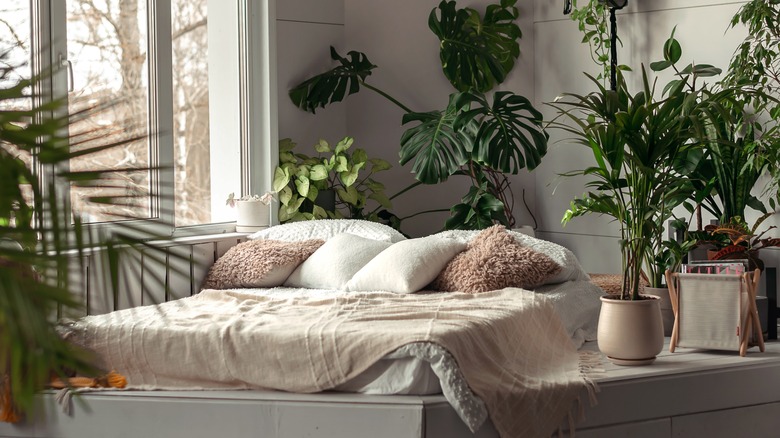How Plant Respiration And Photosynthesis Affect Air Quality In Your Home
Of course, we all know that plants need oxygen to survive, but how often do you stop to think about a plant actually breathing? They may not have the same lung structure as humans and animals, but just like us, they do go through a process called respiration. If you think back to high school science class, you may remember the term photosynthesis and have a basic idea that it's the process by which plants transform light energy from the sun into chemical energy and complex carbohydrates they can use as food. During photosynthesis, plants take in carbon dioxide and water, then release oxygen. An easy way to think about plant respiration is that it's the opposite process. During respiration, plants use oxygen to break down complex carbohydrates, then release carbon dioxide and water.
Again, like us, plants are always taking in oxygen; therefore, the respiration process happens at a constant rate (unlike photosynthesis which only occurs during the day). Since we understand that excess carbon dioxide in the home is a bad thing, this may lead to some confusion about whether houseplants actually improve our air quality or make it worse. Scientists who have studied this agree that houseplants are at least somewhat beneficial when it comes to indoor air quality, so let's take a closer look to understand how it works.
The beneficial effects of plant photosynthesis on indoor air quality
As far back as 1989, when NASA scientist B.C. Wolverton produced a study on the topic, it has been understood that plants have the ability to remove harmful organic chemicals such as benzene, trichloroethylene, and formaldehyde from the air. "That's the reason why humans are able to live on this planet, because plants have purified the air," said Wolverton. "And we are using this ability of the plant in our pots" (via NASA). Much of this work happens below the surface of the soil; the study explains that plant roots and the microorganisms that live in the soil kill those harmful organic chemicals along with bacteria and viruses. Perhaps the most fascinating part is that plants can then turn those pollutants into healthy new cell tissue.
Even so, you'll find conflicting information when you search for it. More recent studies have found that, while plants are beneficial, they are not always able to make a significant improvement in indoor air quality (via Breeze Technologies). Whether it's the species of plant, the specific combination of chemicals and volatile organic compounds (VOC) in the air, or the light and moisture conditions within the home, results tend to be excessively varied. We must understand that though they help, they cannot be the sole cure. More effective solutions include better air circulation and ventilation and, where possible, removing whatever it is that is causing the low air quality in the first place.
Does CO2 from plant respiration negatively impact indoor air quality?
We understand why it's good to have plants in the house absorbing carbon dioxide through photosynthesis and generally making our interiors feel relaxing and connected to nature. But what about the opposite process of respiration when they release carbon dioxide into the air? Is it really safe to incorporate flora throughout the home, especially in the bedroom, where we spend many hours sleeping and breathing right next to our constantly respirating houseplants?
The answer is a simple yes; it is safe. This is because, regardless of what level of exuberant houseplant enthusiast you have achieved, you will never have enough of them to actually cause harm. In fact, according to BBC Science Focus, we humans naturally produce more carbon dioxide emissions while we're sleeping than our plants do. So, with that tidbit of information in your back pocket, go ahead and dive into the nature-infused biophilic design craze and green up your house until your heart is content.


